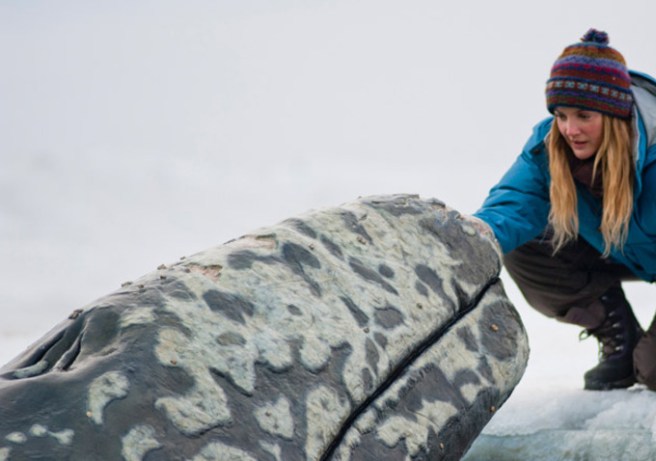Viewed July 22, 2012
 The heartwarming family drama Big Miracle (Ken Kwapis, 2012), about a heroic whale rescue, is the last movie in which I suspected I would find virtually no glaring flaws. It’s certainly not perfect—it has an unnecessary romantic ending and it is a little slow—but I was definitely impressed with its expansive yet tight script. Here’s a quick rundown of its attributes; there are some spoilers ahead.
The heartwarming family drama Big Miracle (Ken Kwapis, 2012), about a heroic whale rescue, is the last movie in which I suspected I would find virtually no glaring flaws. It’s certainly not perfect—it has an unnecessary romantic ending and it is a little slow—but I was definitely impressed with its expansive yet tight script. Here’s a quick rundown of its attributes; there are some spoilers ahead.
It’s a stupid title (the original, working title is the equally bad Everybody Loves Whales), but it teaches a valuable lesson for everyone, children and adults alike: not only is it possible to do the impossible, but it’s best if you try through collaboration, even with people whose ideologies you don’t share. Big Miracle is a dramatization of Operation Breakthrough, the 1988 exercise in international relations that saw the United States and the Soviet Union team up to break free a family of three California gray whales who found themselves trapped in a hole in the ice near Point Barrow, Alaska, five miles away from the open ocean.
Actually, what impressed me most about Jack Amiel and Michael Begler’s screenplay (based on Tom Rose’s nonfiction book Freeing the Whales) was how they managed to incorporate so many perspectives on the event. If I’m not mistaken, these voices include those of the native Inupiat people who worship, eat, and communicate with whales; an incredibly determined but arrogant Greenpeace worker; an evil capitalist from a large oil-drilling company who joins the effort in pursuit of some good PR; the parasitic TV news media in search of a good story and to further their own careers on a temporary national stage; a pair of well-meaning Midwestern inventor-opportunists; a member of President Reagan’s staff, who hopes the story will ensure a favorable legacy for the President as well as an effective quick-start for Vice President George H.W. Bush’s presidential campaign; a colonel from the National Guard, who aims to crack hundreds of miles of ice by pulling the oil-man’s barge with helicopters, but soon gets stuck; and a Soviet-manned icebreaker ship that swoops in to save the day—just in time.

Phew! Did you get all that? It’s ambitious, and it works. It might even cohere better than all the narrative strands of Steven Soderbergh’s apocalyptic horror story Contagion (2011). However, I wish the filmmakers hadn’t inserted a subplot involving the former lovers Adam Carlson (John Krasinski), the local TV news reporter who breaks the story, and Rachel Kramer (Drew Barrymore), the dogmatic “pain-in-the-ass” from Greenpeace. So much of their interaction throughout the film is absent of romantic yearning and desire (they have more pressing concerns) that their reconciliation in the end seems forced.
The script and the performances convincingly relate the isolation of Point Barrow, the northernmost point of the United States, as well as the inhospitable climate for the many outsiders who descend upon the small town, including the gray whales, affectionately named Fred, Wilma, and Bamm Bamm after the animated, prehistoric Flintstones family. (Since the baby whale is a male, they opt not to dub him Pebbles and look to the Rubbles clan for inspiration.) Despite this chilly environment, Point Barrow is warmly rendered, its representation hinging on the connection that Adam has with a young Inupiat boy, Nathan (Ahmaogak Sweeney), who longs to leave the community but through this experience learns the value of his culture, thanks to his intuitive grandfather Malik (John Pingayak), who’s also a community elder. More than this, Point Barrow is kinda quirky, a spiritual twin city of the fictional Pawnee, Indiana, featured in the splendid Parks and Recreation (2009-present). For instance, the only restaurant in town is called Amigos, a Mexican cantina that serves as the base of operations for many different interest groups when they are away from the site. It’s touching that its name reminds people of the importance of friendship.
Big Miracle is ostensibly a family film in the vein of Dolphin Tale (Charles Martin Smith, 2011). While there isn’t anything really objectionable (although, I’m sorry to report, Bamm Bamm doesn’t survive, and Sarah Palin makes a “cameo” at the end in some portentous archive footage), the film may be too heady for some children. Since it focuses so much on the seemingly impossible political and bureaucratic maneuvering everyone engages in, I imagine that some youngsters may get bored or frustrated. Not to mention, it also sports an appropriately cynical view of the media, as Los Angeles reporter-on-the-rise Jill Jerard (Kristen Bell) seizes the opportunity to climb the broadcast news ladder to the top by sensationalizing people’s emotions. It’s also upsetting that Adam, smitten with Jill, doesn’t fight to continue reporting on the story he broke nationwide and submits to playing cameraman for Jill before he eventually rejects her editorial style.
The special effects, specifically in the underwater scenes, are definitely more than acceptable, but I am embarrassed to say that I have no idea how they shot those scenes of the whales with their heads above water. In other words, did the filmmakers use real whales? Or did they use mechanical ones, evidently ignoring the lessons Steven Spielberg and co. learned on the set of 1975’s Jaws? (I kid, I kid. I’m sure technologies have advanced so much in the last thirty-seven years that special effects artists know how to work with or around the challenges that water poses to giant synthetic props.)

Well, I’m pleasantly surprised that I haven’t spoiled the entire movie. I recommend Big Miracle in spite of its ridiculous title. It’s funny and sad—perhaps a little too precious—but it’s altogether human.

